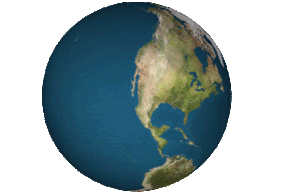戴美克森氏地图投影
| 此条目翻译品质不佳。 (2024年1月8日) |


戴美克森氏地图或称富勒地图是一个投影一个的世界地图上的表面二十面体,其可以展开并变2D平面地图。由美国人巴克敏斯特·富勒发明。
1946年已经获得专利。此时的实例十四面体有序被示出投影到(矢量平衡体)。
1954年在瀚洋世界地图的版本,使用了修改,但大多是经常二十面体为基础的投影,这是为现今最常用的版本。
不同于许多其它的投影方法中,戴美克森氏地图旨在精确地呈现在地球在整个表面上。
特点[编辑]
这张地图在世界地图的其余部分有几个优点,以及富勒说:
其他地图投影,可以说是类似的东西。
除了特别的事情是,是,戴美克森氏地图没有“正确的向上方向”。富勒认为,在宇宙中没有上、下、北、南,只有内外分别,内意思是:恒星和行星的重力;外意思是:远离重力中心。富勒认为大多数其他世界上北下南的的分法是一种文化偏见。
Fuller intended the map to be unfolded in different ways to emphasize different aspects of the world.[1] Peeling the triangular faces of the icosahedron apart in one way results in an icosahedral net that shows an almost contiguous land mass comprising all of Earth's continents – not groups of continents divided by oceans. Peeling the solid apart in a different way presents a view of the world dominated by connected oceans surrounded by land.
参见[编辑]
参考[编辑]
- ^ "Frequently Asked Questions About The Fuller Projection" (页面存档备份,存于互联网档案馆), Buckminster Fuller Institute, 1992, accessed 2010-07-28
外部连接[编辑]
- DYMAX REDUX, a design competition for a fresh take on the dymaxion projection by the Buckminster Fuller Institute (页面存档备份,存于互联网档案馆)
- Fuller Map homepage (页面存档备份,存于互联网档案馆)
- Dymaxion Project Animation
- Icosahedron and Fuller maps (页面存档备份,存于互联网档案馆)
- Dynamically generated maps based on the Dymaxion projection (页面存档备份,存于互联网档案馆)
